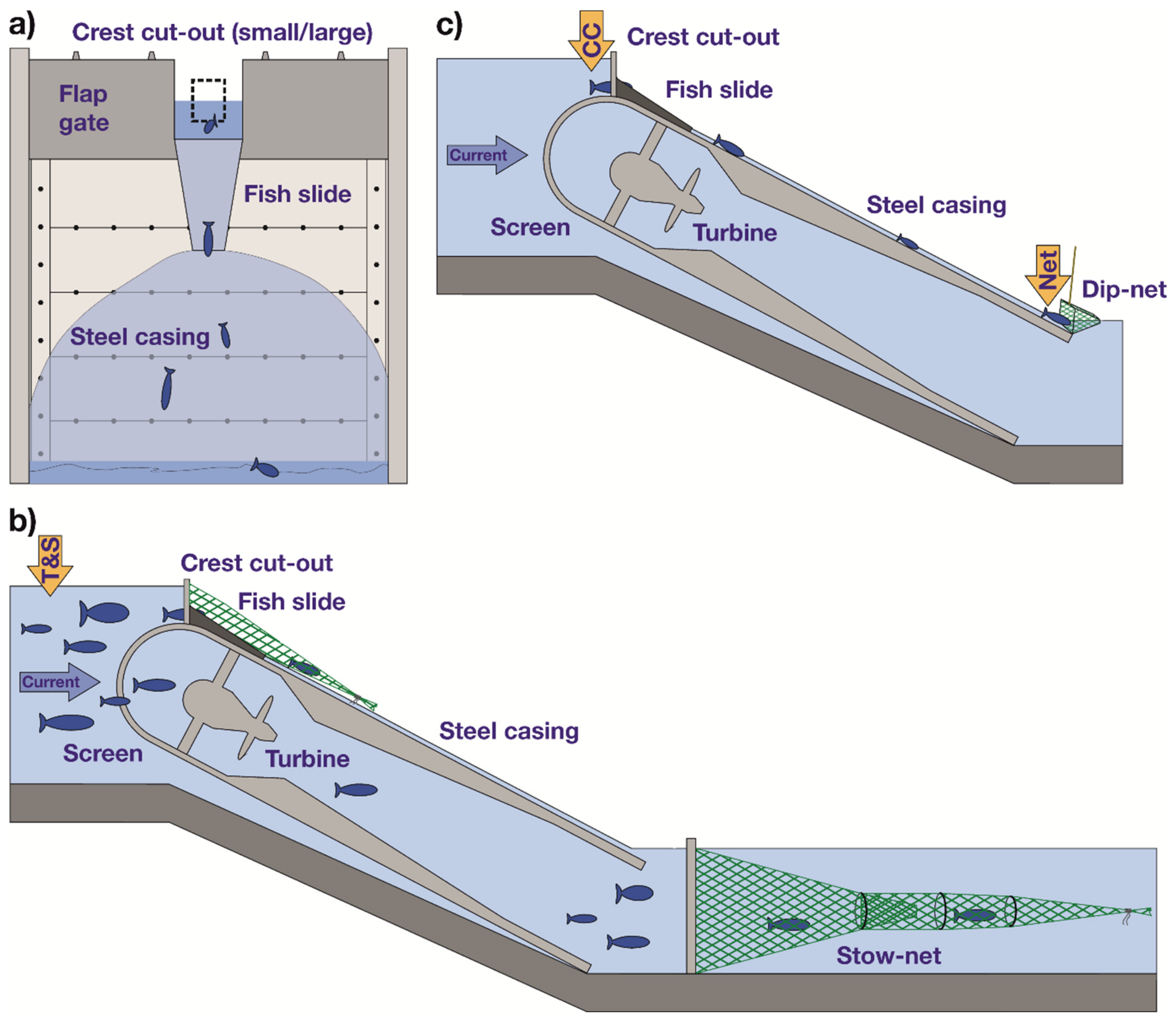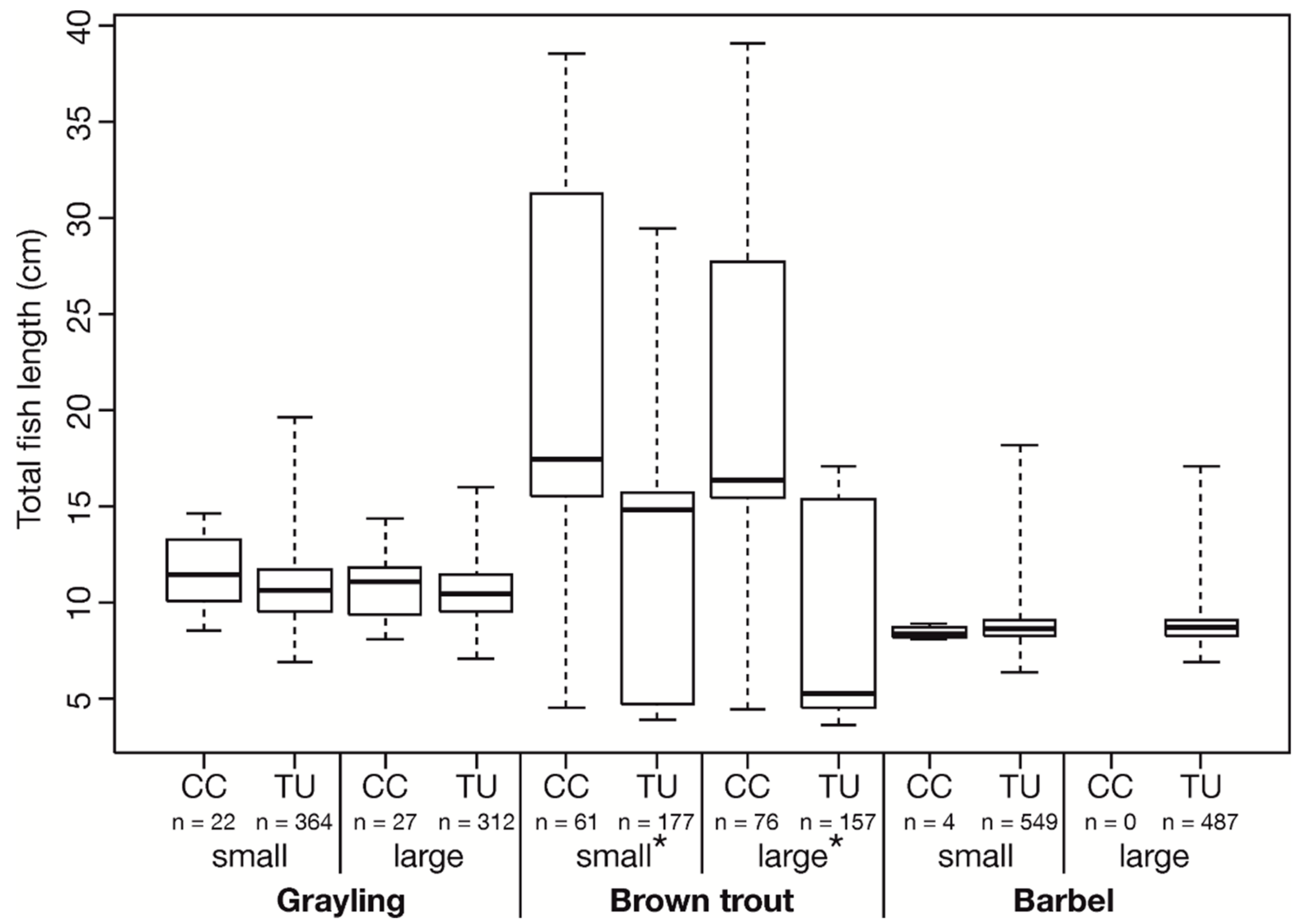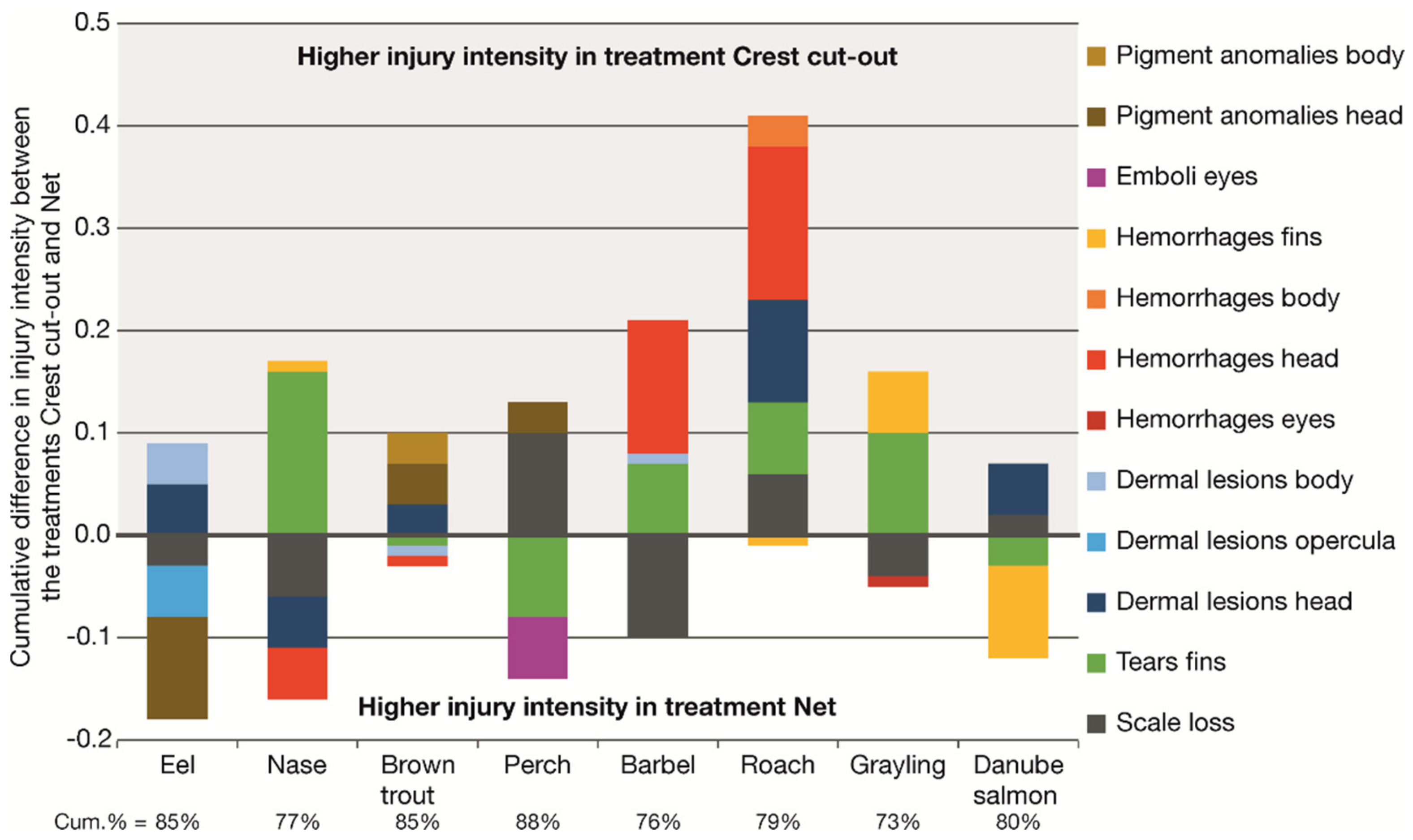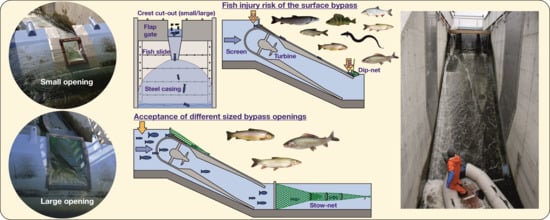Fish Passage and Injury Risk at a Surface Bypass of a Small-Scale Hydropower Plant
Abstract
1. Introduction
2. Materials and Methods
2.1. Study Site
2.2. Experimental Design
2.2.1. Acceptance of Different Sized Crest Cut-Outs
2.2.2. Fish Injury Risk of the Downstream Migration Corridor Crest Cut-Out
2.3. Statistical Analyses
3. Results
3.1. Acceptance of Different Sized Crest Cut-Outs
3.2. Fish Injury Risk of the Downstream Migration Corridor Crest Cut-Out
4. Discussion
4.1. Acceptance of Different Sized Crest Cut-Outs
4.2. Fish Injury Risk of the Downstream Migration Corridor Crest Cut-Out
5. Conclusions
Author Contributions
Funding
Acknowledgments
Conflicts of Interest
References
- Prado, F.A., Jr.; Athayde, S.; Mossa, J.; Bohlman, S.; Leite, F.; Oliver-Smith, A. How much is enough? An integrated examination of energy security, economic growth and climate change related to hydropower expansion in Brazil. Renew. Sust. Energ. Rev. 2016, 53, 1132–1136. [Google Scholar] [CrossRef]
- Zarfl, C.; Lumsdon, A.E.; Berlekamp, J.; Tydecks, L.; Tockner, K. A global boom in hydropower dam construction. Aquat. Sci. 2015, 77, 161–170. [Google Scholar] [CrossRef]
- Grill, G.; Lehner, B.; Lumsdon, A.E.; MacDonald, G.K.; Zarfl, C.; Liermann, C.R. An index-based framework for assessing patterns and trends in river fragmentation and flow regulation by global dams at multiple scales. Environ. Res. Lett. 2015, 10, 015001. [Google Scholar] [CrossRef]
- Mueller, M.; Pander, J.; Geist, J. The effects of weirs on structural stream habitat and biological communities. J. Appl. Ecol. 2011, 48, 1450–1461. [Google Scholar] [CrossRef]
- Nilsson, C.; Reidy, C.A.; Dynesius, M.; Revenga, C. Fragmentation and flow regulation of the world’s large river systems. Science 2005, 308, 405–408. [Google Scholar] [CrossRef]
- Larinier, M. Dams and fish migration. In Dams, Ecosystem Functions and Environmental Restoration. Thematic Review II.1 prepared as an input to the World Commission on1.TROPICAL ENVIRONMENT41 Dams; Berkamp, G., McCartney, M., Dugan, P., McNeely, J., Acreman, M., Eds.; World Commission on Dams: Cape Town, South Africa, 2000; pp. 1–30. [Google Scholar]
- Lucas, M.C.; Baras, E. Migration of Freshwater Fishes, 47th ed.; Blackwell Science: Oxford, UK, 2001; p. 420. [Google Scholar] [CrossRef]
- Noonan, M.J.; Grant, J.W.; Jackson, C.D. A quantitative assessment of fish passage efficiency. Fish Fish. 2012, 13, 450–464. [Google Scholar] [CrossRef]
- Northcote, T. Migratory behaviour of fish and its significance to movement through riverine fish passage facilities. In Migration and Fish Bypasses; Jungwirth, M., Schmutz, S., Weiss, S., Eds.; Fishing News Books: Oxford, UK, 1998; pp. 3–18. [Google Scholar]
- Calles, O.; Greenberg, L. Connectivity is a two-way street—the need for a holistic approach to fish passage problems in regulated rivers. River Res. Appl. 2009, 25, 1268–1286. [Google Scholar] [CrossRef]
- Larinier, M. Fish passage experience at small-scale hydro-electric power plants in France. Hydrobiologia 2008, 609, 97–108. [Google Scholar] [CrossRef]
- Williams, J.G.; Armstrong, G.; Katopodis, C.; Larinier, M.; Travade, F. Thinking like a fish: a key ingredient for development of effective fish passage facilities at river obstructions. River Res. Appl. 2012, 28, 407–417. [Google Scholar] [CrossRef]
- Čada, G.F. The development of advanced hydroelectric turbines to improve fish passage survival. Fisheries 2001, 26, 14–23. [Google Scholar] [CrossRef]
- Haro, A.; Odeh, M.; Noreika, J.; Castro-Santos, T. Effect of water acceleration on downstream migratory behavior and passage of Atlantic salmon smolts and juvenile American shad at surface bypasses. T. Am. Fish. Soc. 1998, 127, 118–127. [Google Scholar] [CrossRef]
- Schilt, C.R. Developing fish passage and protection at hydropower dams. Appl. Anim. Behav. Sci. 2007, 104, 295–325. [Google Scholar] [CrossRef]
- Hogan, T.W.; Čada, G.F.; Amaral, S.V. The status of environmentally enhanced hydropower turbines. Fisheries 2014, 39, 164–172. [Google Scholar] [CrossRef]
- Egg, L.; Pander, J.; Mueller, M.; Geist, J. Effectiveness of the electric fish fence as a behavioural barrier at a pumping station. Mar. Freshw. Res. 2019, 70, 1459–1464. [Google Scholar] [CrossRef]
- Larinier, M.; Travade, F. Downstream migration: problems and facilities. Bull. Fr. Pêche Piscic. 2002, 364, 181–207. [Google Scholar] [CrossRef]
- Egg, L.; Mueller, M.; Pander, J.; Knott, J.; Geist, J. Improving European Silver Eel (Anguilla anguilla) downstream migration by undershot sluice gate management at a small-scale hydropower plant. Ecol. Eng. 2017, 106, 349–357. [Google Scholar] [CrossRef]
- Gosset, C.; Travade, F.; Durif, C.; Rives, J.; Elie, P. Tests of two types of bypass for downstream migration of eels at a small hydroelectric power plant. River Res. Appl. 2005, 21, 1095–1105. [Google Scholar] [CrossRef]
- Katopodis, C. Developing a toolkit for fish passage, ecological flow management and fish habitat works. J. Hydraul. Res. 2005, 43, 451–467. [Google Scholar] [CrossRef]
- Scruton, D.A.; McKinley, R.S.; Kouwen, N.; Eddy, W.; Booth, R.K. Use of telemetry and hydraulic modeling to evaluate and improve fish guidance efficiency at a louver and bypass system for downstream-migrating Atlantic salmon (Salmo salar) smolts and kelts. Hydrobiologia 2002, 483, 83–94. [Google Scholar] [CrossRef]
- Calles, O.; Karlsson, S.; Hebrand, M.; Comoglio, C. Evaluating technical improvements for downstream migrating diadromous fish at a hydroelectric plant. Ecol. Eng. 2012, 48, 30–37. [Google Scholar] [CrossRef]
- Roscoe, D.W.; Hinch, S.G. Effectiveness monitoring of fish passage facilities: Historical trends, geographic patterns and future directions. Fish Fish. 2010, 11, 12–33. [Google Scholar] [CrossRef]
- Geist, J.; Hawkins, S.J. Habitat recovery and restoration in aquatic ecosystems: Current progress and future challenges. Aquat. Conserv. 2016, 26, 942–962. [Google Scholar] [CrossRef]
- Johnson, G.E.; Anglea, S.M.; Adams, N.S.; Wik, T.O. Evaluation of a prototype surface flow bypass for juvenile salmon and steelhead at the powerhouse of Lower Granite Dam, Snake River, Washington, 1996–2000. N. Am. J. Fish Manag. 2005, 25, 138–151. [Google Scholar] [CrossRef]
- Scruton, D.A.; Pennell, C.J.; Bourgeois, C.E.; Goosney, R.F.; Porter, T.R.; Clarke, K.D. Assessment of a retrofitted downstream fish bypass system for wild Atlantic salmon (Salmo salar) smolts and kelts at a hydroelectric facility on the Exploits River, Newfoundland, Canada. Hydrobiologia 2007, 582, 155–169. [Google Scholar] [CrossRef]
- European Parliament. Directive 2010/63/EU of the European Parliament and of the Council of 22 September 2010 on the protection of animals used for scientific purposes. Off. J. Eur. Union 2010, 276, 33–77. [Google Scholar]
- Adam, B.; Schürmann, M.; Schwevers, U. Zum Umgang mit Aquatischen Organismen – Versuchstierkundliche Grundlagen; Springer Spektrum: Wiesbaden, Germany, 2013; p. 188. [Google Scholar] [CrossRef]
- Ebel, G. Fischschutz und Fischabstieg an Wasserkraftanlagen – Handbuch Rechen- und Bypasssysteme. Ingenieurbiologische Grundlagen, Modellierung und Prognose, Bemessung und Gestaltung, 1st ed.; Büro für Gewässerökologie und Fischereibiologie: Halle (Saale), Germany, 2013; p. 483. [Google Scholar]
- Pander, J.; Mueller, M.; Knott, J.; Geist, J. Catch-related fish injury and catch efficiency of stow-net-based fish recovery installations for fish-monitoring at hydropower plants. Fish. Manag. Ecol. 2018, 25, 31–43. [Google Scholar] [CrossRef]
- Mueller, M.; Pander, J.; Geist, J. Evaluation of external fish injury caused by hydropower plants based on a novel field-based protocol. Fish. Manag. Ecol. 2017, 24, 240–255. [Google Scholar] [CrossRef]
- R Core Team. R: A language and Environment for Statistical Computing; R Foundation for Statistical Computing: Vienna, Austria, 2017; Available online: https://www.R-project.org/ (accessed on 6 June 2019).
- Bates, D.; Maechler, M.; Bolker, B.; Walker, S. Fitting linear mixed-effects models using lme4. J. Stat. Softw. 2014, 67, 1–48. [Google Scholar] [CrossRef]
- Zuur, A.F.; Ineo, E.N.; Walker, N.J.; Saveliev, A.A.; Smith, G.M. Mixed Effects Models and Extensions in Ecology with R; Springer Science and Business Media: New York, NY, USA, 2009; p. 574. [Google Scholar] [CrossRef]
- Bray, J.R.; Curtis, J.T. An ordination of upland forest communities of southern Wisconsin. Ecol. Monogr. 1957, 27, 325–349. [Google Scholar] [CrossRef]
- Clarke, K.R.; Somerfield, P.J.; Chapman, M.G. On resemblance measures for ecological studies, including taxonomic dissimilarities and a zero-adjusted Bray-Curtis coefficient for denuded assemblages. J. Exp. Mar. Biol. Ecol. 2006, 330, 55–80. [Google Scholar] [CrossRef]
- Clarke, K.R. Non-parametric multivariate analyses of changes in community structure. Austral. Ecol. 1993, 18, 117–143. [Google Scholar] [CrossRef]
- Clarke, K.R.; Gorley, R.N.; Somerfield, P.J.; Warwick, R.M. Change in Marine Communities: An Approach to Statistical Analysis and Interpretation, 3rd ed.; PRIMER-E Ltd.: Plymouth, UK, 2014; p. 256. [Google Scholar]
- Bickford, S.A.; Skalski, J.R. Reanalysis and interpretation of 25 years of Snake-Columbia River juvenile salmonid survival studies. N. Am. J. Fish Manag. 2000, 20, 53–68. [Google Scholar] [CrossRef]
- Muir, W.D.; Smith, S.G.; Williams, J.G.; Sandford, B.P. Survival of juvenile salmonids passing through bypass systems, turbines, and spillways with and without flow deflectors at Snake River dams. N. Am. J. Fish Manag. 2001, 21, 135–146. [Google Scholar] [CrossRef]
- Knott, J.; Mueller, M.; Pander, J.; Geist, J. Seasonal and diurnal variation of downstream fish movement at four small-scale hydropower plants. Ecol. Freshw. Fish. (in press). [CrossRef]
- Pander, J.; Mueller, M.; Geist, J. Ecological functions of fish bypass channels in streams: Migration corridor and habitat for rheophilic species. River Res. Appl. 2013, 29, 441–450. [Google Scholar] [CrossRef]
- Travade, F.; Larinier, M.; Subra, S.; Gomes, P.; De-Oliveira, E. Behaviour and passage of European silver eels (Anguilla anguilla) at a small hydropower plant during their downstream migration. Knowl. Manag. Aquat. Ec. 2010, 398, 1–19. [Google Scholar] [CrossRef]
- Arnekleiv, J.V.; Kraabøl, M.; Museth, J. Efforts to aid downstream migrating brown trout (Salmo trutta L.) kelts and smolts passing a hydroelectric dam and a spillway. In Developments in Fish Telemetry; Almeida, P.R., Quintella, B.R., Costa, M.J., Moore, A., Eds.; Springer: Dordrecht, Germany, 2007; Volume 195, pp. 5–15. [Google Scholar] [CrossRef]
- Kottelat, M.; Freyhof, J. Handbook of European Freshwater Fishes; Publications Kottelat, Cornol and Freyhof: Berlin, Germany, 2007; p. 646. [Google Scholar]
- Deng, Z.; Guensch, G.R.; McKinstry, C.A.; Mueller, R.P.; Dauble, D.D.; Richmond, M.C. Evaluation of fish-injury mechanisms during exposure to turbulent shear flow. Can. J. Fish. Aquat. Sci. 2005, 62, 1513–1522. [Google Scholar] [CrossRef]
- Ferguson, J.W.; Sandford, B.P.; Reagan, R.E.; Gilbreath, L.G.; Meyer, E.B.; Ledgerwood, R.D.; Adams, N.S. Bypass system modification at Bonneville Dam on the Columbia River improved the survival of juvenile salmon. T. Am. Fish. Soc. 2007, 136, 1487–1510. [Google Scholar] [CrossRef]
- Pflugrath, B.D.; Boys, C.A.; Cathers, B.; Deng, Z.D. Over or under? Autonomous sensor fish reveals why overshot weirs may be safer than undershot weirs for fish passage. Ecol. Eng. 2019, 132, 41–48. [Google Scholar] [CrossRef]
- Dastjerdi, A.K.; Barthelat, F. Teleost fish scales amongst the toughest collagenous materials. J. Mech. Behav. Biomed. 2015, 52, 95–107. [Google Scholar] [CrossRef]




| Small Crest Cut-Out | Large Crest Cut-Out | |
|---|---|---|
| Turbidity (NTU) | 3.4 ± 0.7 (2.4–4.1) | 3.1 ± 0.5 (2.3–3.9) |
| Dissolved oxygen (mg L−1) | 9.9 ± 0.4 (9.3–10.6) | 10.1 ± 0.5 (9.5–10.7) |
| Temperature (°C) | 12.1 ± 0.2 (11.9–12.3) | 11.1 ± 0.2 (10.9–11.5) |
| pH-value | 7.7 ± 0.1 (7.6–7.8) | 7.5 ± 0.1 (7.3–7.7) |
| Electric conductivity (µS cm−1) | 179 ± 4 (175–184) | 174 ± 4 (170–178) |
| Discharge (m³ s−1) | 3.2 ± 0.1 (3.0–3.3) | 3.0 ± 0.2 (2.8–3.3) |
| Current speed (m s−1) | 0.38 ± 0.02 (0.36–0.40) | 0.40 ± 0.02 (0.38–0.43) |
| Grayling | Brown Trout | Barbel | Overall | |||||
|---|---|---|---|---|---|---|---|---|
| Small | Large | Small | Large | Small | Large | Small | Large | |
| N total | 754 | 721 | 1509 | 1442 | 1226 | 1236 | 3489 | 3399 |
| N caught CC | 22 (5.7%) | 27 (8.0%) | 61 (25.6%) | 76 (32.6%) | 4 (0.7%) | 0 (0.0%) | 87 (7.4%) | 103 (9.7%) |
| N caught TU | 364 (94.3%) | 312 (92.0%) | 177 (74.4%) | 157 (67.4%) | 549 (99.3%) | 487 (100.0%) | 1090 (92.6%) | 956 (90.3%) |
| TL AM ± SD (cm) | 10.9 ± 1.8 | 10.6 ± 1.6 | 14.6 ± 8.2 | 13.1 ± 8.1 | 8.9 ± 1.5 | 8.9 ± 1.4 | 10.7 ± 4.5 | 10.4 ± 4.4 |
| TL MIN–MAX (cm) | 6.9–19.6 | 7.1–16.0 | 3.9–38.5 | 3.6–39.1 | 6.3–18.2 | 6.9–17.1 | 3.9–38.5 | 3.6–39.1 |
| N CC (%)/inflow CC (%) | 9.9 | 2.2 | 44.4 | 9.2 | 1.3 | 0.0 | 12.8 | 2.7 |
| N TU (%)/inflow TU (%) | 0.9 | 1.0 | 0.7 | 0.7 | 1.0 | 1.0 | 0.9 | 0.9 |
| Scientific Name | Common Name | N Crest cut-out | N Net | TL Am | TL Min | TL Max |
|---|---|---|---|---|---|---|
| Anguilla anguilla | Eel | 40 | 40 | 44.2 | 28.0 | 71.4 |
| Thymallus thymallus | Grayling | 40 | 40 | 16.5 | 7.8 | 28.3 |
| Salmo trutta | Brown trout | 43 | 40 | 19.3 | 5.1 | 35.8 |
| Barbus barbus | Barbel | 41 | 40 | 10.8 | 5.8 | 17.8 |
| Perca fluviatilis | Perch | 40 | 40 | 11.1 | 8.5 | 13.2 |
| Hucho hucho | Danube salmon | 41 | 40 | 28.8 | 12.9 | 39.8 |
| Chondrostoma nasus | Nase | 40 | 40 | 10.8 | 7.2 | 16.5 |
| Rutilus rutilus | Roach | 55 | 40 | 14.1 | 11.0 | 19.4 |
| Number of Injuries | Injury Intensity | |
|---|---|---|
| AIC | 6962.5 | 8687.5 |
| Residuals: | ||
| Minimum | −2.72 | −2.50 |
| First quartile | −0.61 | −0.61 |
| Median | −0.06 | −0.09 |
| Third quartile | 0.58 | 0.47 |
| Maximum | 6.51 | 6.72 |
| Fixed effects: | ||
| Total length | χ2 = 49.69 *** | χ2 = 42.35 *** |
| Species | χ2 = 884.5 *** | χ2 = 867.1 *** |
| Random effects: | ||
| Treatment | SD = 1.44 | SD = 2.45 |
| Residual | SD = 3.49 | SD = 6.82 |
© 2019 by the authors. Licensee MDPI, Basel, Switzerland. This article is an open access article distributed under the terms and conditions of the Creative Commons Attribution (CC BY) license (http://creativecommons.org/licenses/by/4.0/).
Share and Cite
Knott, J.; Mueller, M.; Pander, J.; Geist, J. Fish Passage and Injury Risk at a Surface Bypass of a Small-Scale Hydropower Plant. Sustainability 2019, 11, 6037. https://doi.org/10.3390/su11216037
Knott J, Mueller M, Pander J, Geist J. Fish Passage and Injury Risk at a Surface Bypass of a Small-Scale Hydropower Plant. Sustainability. 2019; 11(21):6037. https://doi.org/10.3390/su11216037
Chicago/Turabian StyleKnott, Josef, Melanie Mueller, Joachim Pander, and Juergen Geist. 2019. "Fish Passage and Injury Risk at a Surface Bypass of a Small-Scale Hydropower Plant" Sustainability 11, no. 21: 6037. https://doi.org/10.3390/su11216037
APA StyleKnott, J., Mueller, M., Pander, J., & Geist, J. (2019). Fish Passage and Injury Risk at a Surface Bypass of a Small-Scale Hydropower Plant. Sustainability, 11(21), 6037. https://doi.org/10.3390/su11216037





